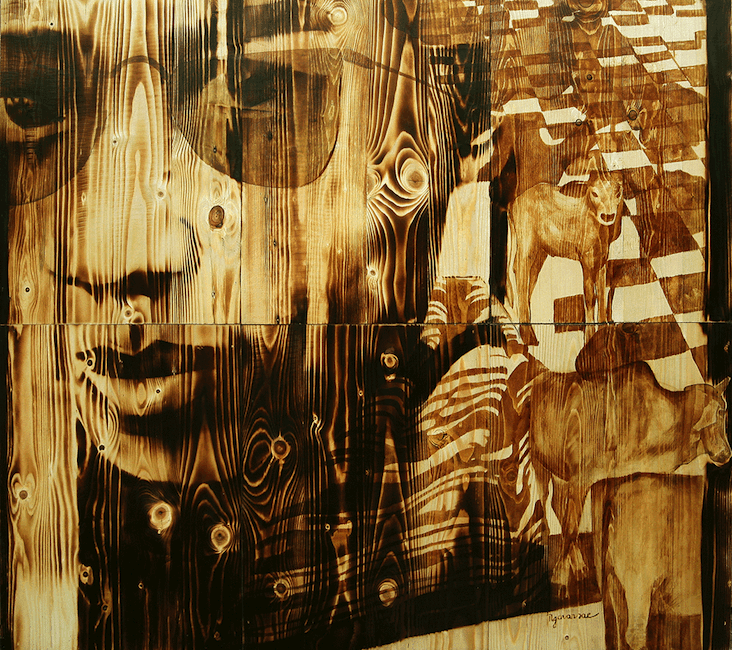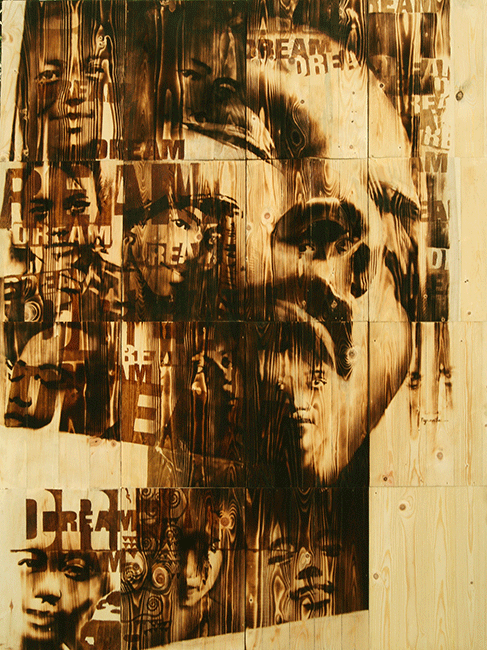In the Midst of Life – Ngo Van Sac
Opening Reception: 25 October 2013, 6 - 9 pm
25 October - 25 November 2013
During his eight years training at Hanoiâs Fine Arts University, Ngo Van Sac practiced using traditional media: charcoal, silk painting, lacquer, oils, and more. He is one of those artists that relishes technique. Some artists are compelled to play with and control (or purposefully lose control of) art materials. Sac crafts his work attentively, and the results show the care he gives, and the exciting outcomes of experimentation.
This determined artist has developed his own way of working with natural…
During his eight years training at Hanoiâs Fine Arts University, Ngo Van Sac practiced using traditional media: charcoal, silk painting, lacquer, oils, and more. He is one of those artists that relishes technique. Some artists are compelled to play with and control (or purposefully lose control of) art materials. Sac crafts his work attentively, and the results show the care he gives, and the exciting outcomes of experimentation.
This determined artist has developed his own way of working with natural…
During his eight years training at Hanoi’s Fine Arts University, Ngo Van Sac practiced using traditional media: charcoal, silk painting, lacquer, oils, and more. He is one of those artists that relishes technique. Some artists are compelled to play with and control (or purposefully lose control of) art materials. Sac crafts his work attentively, and the results show the care he gives, and the exciting outcomes of experimentation.
This determined artist has developed his own way of working with natural materials. Ngo Van Sac says that one day he may return to using conventional canvas, but right now he is enchanted by the blocks of fresh, untreated wood that grip his images with rawness. The curved veins in the wood’s surface take the eyes gently up and down the portraits, sneaking into the intricacies of the pictures. Details appear at bicycle pace, partly due to the clever placement of faces inside faces, but also to the double exposure effect of the portrait overlapping the wood’s pattern.
The making process must involve a lot of planning, but the artworks are never overdone. Minimal color and simple materials prevent visual saturation. Sac pencils the outlines onto the wooden blocks, then blowtorches them, masking off areas with a metal spatula to modulate the color. The burnt images are surprisingly detailed, and fire alone cannot offer such sharpness. A pyrography pen could work for strong lines, but Sac’s imagery is dominated by silhouettes and color gradation, not by linear drawing, so a gas blowtorch works best. The next step is to define the highlights more precisely. Small dark patches can be lightened or erased with a sander, uncovering the original creamy color of the pure wood.
In some works, a silkier brown is introduced next to the dry, burnt surfaces. These honeyed details are painted with natural Vietnamese lacquer, sơn cánh gián (a cockroach wing brown tree resin), which gives a soft gloss finish.
Sac’s working methods demonstrate mastery of the materials, but he ascribes no ulterior meaning to the making process. This is common in intuitive artists. The aesthetics are very important, but they resolve themselves almost effortlessly, by instinct. Sac enjoys his materials, but he is focused on his destination more than on the drive. What he wants to express is not determined by process, but by the subject matter he chooses.
Portraits are his theme. Human figures are solidly consistent presences in Ngo Van Sac’s trajectory, although his mother, who is a painter, and his brother, a photographer, have both chosen landscapes as their topic. Sac has always painted people. In previous exhibitions, he has shown historical characters with older, wiser faces, or sometimes groups of sitters. This time, he turns inwards. This exhibition probably has more self-portraits by a single artist than any other solo show anywhere. While such a quantity of self-portraits could be construed as self-indulgent, it is actually an honest search, and an expression of personal emotion, of the type that is not always articulated in day-to-day interactions.
Giữa đời – In the midst of life, the title of the exhibition, and of several of the artworks in it, suggests Sac’s thought process. In Vietnam, the hustle and bustle of life is voraciously engulfing. Here, we are constantly surrounded by vitality. But the title reminds us that life is a passage, and there are marker points in it.
In the West, there is talk of the ‘quarter life crisis’ hitting around one’s early 30s. A highly competitive marketplace, student debt, the pressures of mortgages and relationships are some of the alleged factors behind young Westerner’s blues. Research in Vietnam, a country that appears to bloom with burning energy, is yet to show if the thirty somethings here also enter a cycle of depression/self-reflection. The work of some artists born post-reunification, such as Phạm Huy Thông or Bùi Thanh Tâm, does illustrate some worries of the vast young population in Vietnam, confronted with fast change.
Ngo Van Sac, of the same generation, instead of honing in on the causes of life’s tribulations, explores the internal conflict, which is sometimes a battle with external stressors, but sometimes is just a deeply honest conversation with selfhood. ‘Our young generation does not have much space to help us to learn about previous generations,’ he says, ‘we are swept by the rushed rhythm of life.’
Confronting his own values and desires, he exposes hundreds of facets of himself. The inward gaze compels him to examine his personality, which he believes is formed from several moments, moods, piling themselves up like chapters in a novel.
Bicycles, trees and water lilies fade their way into the images, like déjà-vues of a tranquil lifestyle that is almost mythical for the urban youth. Sac grew up in a village 20 kilometers from Hanoi. But childhood has gone. Like an increasing number of Vietnamese, the artist is now a city dweller, for whom peace and nature are as inaccessible as memory. As he puts enough history behind his own life, Sac can appreciate its complexity. ‘Many small images in the overall big picture bring depth to my work,’ he comments. He could say the same sentence of life’s journey.
Two installations create the sensation of a flow moving around the wooden shapes. Each prism presents different moods of the artist, under the perspectives of several individuals. The narrative unfolds as the viewer walks around, showing little action. It’s a story of the subtle changes in emotion that come and go all the time.
In one of these sculptural portraits, the artist’s happy expressions zigzag around a star shape that has lost its heart. Unsurprisingly, since a Louis Vuitton pattern dominates the piece from above, reflecting how brands take consumers as prisoners.
The market economy, Sac thinks, ‘is the most accurate machine’ to purge society from ‘those who are not strong enough and lose themselves in temptation.’ Existence, he reflects, is for those who can find balance. Compelled towards consumerism but held back by the yearnings of an idyllic slow life not long past, the young Vietnam cannot move forward until it resolves its 21st century unease.
By Cristina Nualart
September, 2013
Read more
Read less





















